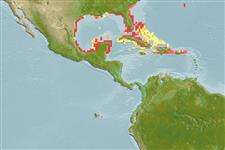Common names from other countries
Environment: milieu / climate zone / depth range / distribution range
Ökologie
seewasser demersal; standorttreu; tiefenbereich 0 - 10 m (Ref. 52034). Subtropical; 33°N - 17°N, 99°W - 64°W
Western Atlantic: Bermuda, southern Florida (USA), Bahamas and the entire Gulf of Mexico.
Length at first maturity / Size / Gewicht / Alter
Maturity: Lm 2.1 range ? - ? cm
Max length : 5.0 cm TL Männchen/unbestimmt; (Ref. 7251); max. veröff. Alter: 1.00 Jahre (Ref. 12238)
Rückenflossenstacheln (insgesamt) : 0; Rückenflossenweichstrahlen (insgesamt) : 12.
Shallow grass flats, especially in association with Zostera and other seagrass; periodically found in floating vegetation. Diurnal, males more site faithful than females. Ovoviviparous (Ref. 205). The male carries the eggs in a brood pouch which is found under the tail (Ref. 205). Specimens lose their skin filaments in aquaria (Ref. 30915). Has been reared in captivity (Ref. 35420). Maximum depth reported taken from Ref. 128812.
Monogamous mating is observed as both obligate and genetic (Ref. 52884). Male carries the eggs in a brood pouch (Ref. 205). Female transfers all the eggs in the ovary to the brood pouch of the male (Ref. 1284).
Lourie, S.A., R.A. Pollom and S.J. Foster, 2016. A global revision of the seahorses Hippocampus Rafinesque 1810 (Actinopterygii: Syngnathiformes): taxonomy and biogeography with recommendations for further research. Zootaxa 4146(1):1-66. (Ref. 115213)
IUCN Rote Liste Status (Ref. 130435)
Bedrohung für Menschen
Harmless
Nutzung durch Menschen
Fischereien: weniger kommerziell
Tools
Zusatzinformationen
Download XML
Internet Quellen
Estimates based on models
Preferred temperature (Ref.
115969): 23.4 - 27.8, mean 26.6 (based on 229 cells).
Phylogenetic diversity index (Ref.
82804): PD
50 = 0.5000 [Uniqueness, from 0.5 = low to 2.0 = high].
Bayesian length-weight: a=0.00447 (0.00177 - 0.01127), b=3.00 (2.78 - 3.22), in cm Total Length, based on LWR estimates for this (Sub)family-body shape (Ref.
93245).
Trophic level (Ref.
69278): 3.2 ±0.5 se; based on size and trophs of closest relatives
Widerstandsfähigkeit (Ref.
120179): mittel, Verdopplung der Population dauert 1,4 - 4,4 Jahre. (tm=0.4; tmax=1; assuming Fec=100 (approx. 3 generations/year)).
Fishing Vulnerability (Ref.
59153): Low vulnerability (10 of 100).
